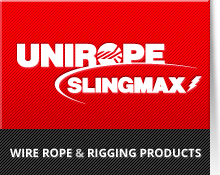|
Corrosion, while difficult to evaluate, is a more serious cause of degradation than abrasion. Usually, it signifies a lack of lubrication. Corrosion will often occur internally before there is any visible external evidence on the rope surface. This is one of the reasons why we developed PYTHON® wire rope with a plastic protected core. The plastic protects the core against corrosion and the user does not have to worry about undetected corrosion which may lead to a sudden and unexpected rope failure. |
Corrosion of the rope core not only attack the metal wires, but also prevents the rope’s component parts from moving smoothly as it flexes. Severe rusting leads to premature fatigue failure of single wires. When the rope shows more than one wire failure near a fitting, it should be removed immediately. To prevent abnormal corrosion, the rope should be kept well lubricated. In situations where abnormal corrosive action can occur, it may be necessary to use galvanized or stainless steel wire rope. |
Corrosion, Rope Removal and Cause
| Fault | Possible Cause |
|---|---|
| Accelerated Wear | Severe abrasion from being dragged over the ground or obstructions. Rope not suitable for application. Poorly aligned sheaves. Large fleet angle. Worn sheave with improper groove, size or shape. Sheaves and rollers have rough wear surface. Stiff or seized sheave bearings. High bearing and contact pressures. Sheaves/drum too small. |
| Rapid Appearance of Broken Wires | Rope not suitable for application. Reverse bends. Sheaves/drums too small. Overload and shock loads. Excessive rope vibration. Kinks that have formed and have been straightened out. Crushing and flattening of the rope. Sheave wobble. |
| Corrosion | Inadequate lubrication. Improper storage. Exposure to acids or alkalis. |
| Kinks | Improper installation. Improper handling. Slack rope pulled tight. |
| Excessive localized Wear | Drumcrushing. Equalizer Sheave. Vibration. |
| Fault | Possible Cause |
|---|---|
| Stretch | Overload. Passed normal stretch and approaches failure. |
| Broken Wires near Fitting | Rope Vibration. Fittings get pulled too close to sheave or drum. |
| Sheaves/Drums Wear out | Material too soft. |
| Pinching, Crushing, oval Shape | Sheaves grooves too small. Not following proper installation and maintenance procedure on multiple layer drums. |
| Rope Unlays (Opens up) | Wrong rope construction. Rope end attached to swivel. |
| Reduction in Diameter | Broken core. Overload. Internal wear. Corrosion. |
| Bird Cage | Tight Sheaves. Rope is forced to rotate around its own axis. Shock loads. Improper Wedge Socket installation. |
| Core Protrusion | Shock loading. Disturbed rope lay. Rope unlays. Load spins and rotates rope around its own axis. |


